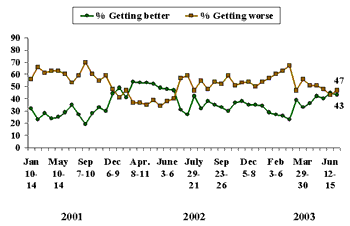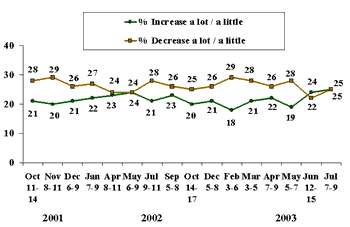GALLUP NEWS SERVICE
PRINCETON, NJ -- Two months ago, Gallup's economic data suggested that the much-anticipated postwar economic rally was much more illusory than real. Last month, consumer perceptions reversed and responded very positively to a host of new economic stimuli ranging from the surging equity markets to a tax cut and lower interest rates. Unfortunately, a new Gallup Poll, conducted July 7-9, reveals that the improvement in consumer sentiment has not continued to gain momentum as the summer has progressed.
Consumer optimism -- like the economy as a whole -- is at a turning point this summer. Apparently, consumers want to be more optimistic about the economic outlook than they were earlier this year. Their spending intentions continue to suggest that retailers could enjoy a pretty good "back-to-school" sales period. Still, consumers aren't seeing any real improvement in current economic conditions. And this needs to change if consumer perceptions and the economy are going to gain significant momentum in the months ahead.
Consumers Say Economic Conditions Are Not Improving
New Gallup Poll economic data show a slight decline in the way the public rates current economic conditions. In July, just about as many consumers continue to rate current economic conditions as "good" or "excellent" (24%) as say they are "poor" (26%) -- a differential of -2 percentage points. This is down from a differential of +1 percentage point in June, when 26% of consumers rated current economic conditions as "good" or "excellent" and 25% rated them as "poor."
As a result, consumer perceptions of the economy remain better than they were in May (in mid-May, the differential was -10 percentage points and in early May, it was -6 percentage points). Still, the consumer's assessment of the economy is nowhere near where it was as the war with Iraq began, with 33% of the public rating economic conditions "good"/"excellent" and 20% rating them "poor," for a differential of +13 percentage points in Gallup's March 24-25 poll. Nor does July's differential reflect as much consumer optimism about the current economy as did the differential (+5 percentage points) as Baghdad fell in early April.
| Rating of Current Economic Conditions |
 |
A Slight Majority Also Says Things Are Getting Worse
Currently, more consumers are saying economic conditions are getting worse (47%) than say they are getting better (43%) -- a differential of -4 percentage points. This means consumers are slightly less optimistic in July about future economic conditions than they were in June, when more consumers said things were getting better (45%) than said they were getting worse (43%) -- a differential of +2. June's reading showed the first positive differential on this question since June of last year, and the percentages for these two months are similar.
| Economic Conditions Getting Better or Getting Worse? |
 |
Still, Consumers' Spending Intentions Remain Reasonably Good
In Gallup's July poll, just as many consumers say they plan to spend more over the next six months (25%) as say they plan to spend less (25%). This zero differential reflects slightly lower spending intentions than those of June, when more consumers (24%) said they planned to spend more over the next six months than said they planned to spend less (22%). Of course, July's zero differential remains much more positive than May's -9 differential.
| In the Next Six Months, Will Your Overall
Spending Increase or Decrease? |
 |
Consumer Optimism Lacks Momentum
The sharp turnaround in June's consumer spending intentions suggested that there was a lot of positive momentum in the public's future economic expectations. The lack of continued improvement -- and the existence of even some modest backtracking -- in July implies that consumer perceptions are at another turning point. And how they turn will say a lot about the future direction of the economy.
One big positive is the distribution of tax refund checks later this month. Although Gallup's data show that only 34% of consumers say the federal tax cuts will be beneficial to their families' finances, refund checks could produce a strong "back-to-school" sales period for retailers. Add in the continuation of historically low interest rates and the continued willingness of consumers to spend, and the retail sector could have a fairly good third quarter.
The problem is that overall consumer optimism -- not to mention business confidence -- is at relatively low levels historically and, even worse, lacks momentum. Like the equity markets -- and corporate America -- consumers seem to be waiting to see real economic improvement before they get too enthusiastic about the direction of the economy.
If the tax cuts combine with stimulative monetary policies to produce some real economic gains in the months ahead, then consumer confidence as well as the overall economy will begin to gain real momentum later this year. If not, we'll all hear a lot more about the jobs recession and how 58% of Americans don't believe the president is paying enough attention to the economy.
Survey Methods
Results are based on telephone interviews with 1,006 national adults, aged 18+, conducted July 7-9, 2003. For results based on this sample, one can say with 95% confidence that the margin of sampling error is ± 3 percentage points. In addition to sampling error, question wording and practical difficulties in conducting surveys can introduce error or bias into the findings of public opinion polls.

